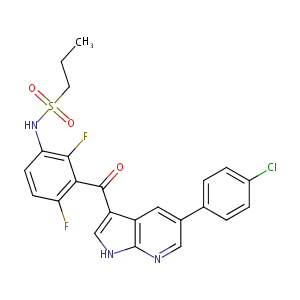| 1 |
Loss of function mutations in VARS encoding cytoplasmic valyl-tRNA synthetase cause microcephaly, seizures, and progressive cerebral atrophy.Hum Genet. 2018 Apr;137(4):293-303. doi: 10.1007/s00439-018-1882-3. Epub 2018 Apr 24.
|
| 2 |
URL: http://www.guidetopharmacology.org Nucleic Acids Res. 2015 Oct 12. pii: gkv1037. The IUPHAR/BPS Guide to PHARMACOLOGY in 2016: towards curated quantitative interactions between 1300 protein targets and 6000 ligands. (Ligand id: 5893).
|
| 3 |
Busulfan FDA Label
|
| 4 |
URL: http://www.guidetopharmacology.org Nucleic Acids Res. 2015 Oct 12. pii: gkv1037. The IUPHAR/BPS Guide to PHARMACOLOGY in 2016: towards curated quantitative interactions between 1300 protein targets and 6000 ligands. (Ligand id: 7136).
|
| 5 |
PLX4032 Mediated Melanoma Associated Antigen Potentiation in Patient Derived Primary Melanoma Cells. J Cancer. 2015 Oct 29;6(12):1320-30. doi: 10.7150/jca.11126. eCollection 2015.
|
| 6 |
Actin remodeling confers BRAF inhibitor resistance to melanoma cells through YAP/TAZ activation. EMBO J. 2016 Mar 1;35(5):462-78. doi: 10.15252/embj.201592081. Epub 2015 Dec 14.
|
| 7 |
Drugs@FDA. U.S. Food and Drug Administration. U.S. Department of Health & Human Services. 2015
|
| 8 |
Differential effects of the oncogenic BRAF inhibitor PLX4032 (vemurafenib) and its progenitor PLX4720 on ABCB1 function. J Pharm Pharm Sci. 2014;17(1):154-68.
|
| 9 |
Contribution of OATP1B1 and OATP1B3 to the disposition of sorafenib and sorafenib-glucuronide. Clin Cancer Res. 2013 Mar 15;19(6):1458-66.
|
| 10 |
Vemurafenib for the treatment of melanoma. Expert Opin Pharmacother. 2012 Dec;13(17):2533-43.
|
| 11 |
Perturbation biology nominates upstream-downstream drug combinations in RAF inhibitor resistant melanoma cells. Elife. 2015 Aug 18;4:e04640. doi: 10.7554/eLife.04640.
|
| 12 |
Role of the protein kinase BRAF in the pathogenesis of endometriosis. Expert Opin Ther Targets. 2016 Aug;20(8):1017-29. doi: 10.1080/14728222.2016.1180367. Epub 2016 May 4.
|
| 13 |
Overcoming melanoma resistance to vemurafenib by targeting CCL2-induced miR-34a, miR-100 and miR-125b. Oncotarget. 2016 Jan 26;7(4):4428-41. doi: 10.18632/oncotarget.6599.
|
| 14 |
Melanoma Expressed-CD70 Is Regulated by RhoA and MAPK Pathways without Affecting Vemurafenib Treatment Activity. PLoS One. 2016 Feb 1;11(2):e0148095. doi: 10.1371/journal.pone.0148095. eCollection 2016.
|
| 15 |
Sustained SREBP-1-dependent lipogenesis as a key mediator of resistance to BRAF-targeted therapy. Nat Commun. 2018 Jun 27;9(1):2500. doi: 10.1038/s41467-018-04664-0.
|
| 16 |
MAPK and SHH pathways modulate type 3 deiodinase expression in papillary thyroid carcinoma. Endocr Relat Cancer. 2016 Mar;23(3):135-46. doi: 10.1530/ERC-15-0162.
|
| 17 |
Paradoxical activation of MEK/ERK signaling induced by B-Raf inhibition enhances DR5 expression and DR5 activation-induced apoptosis in Ras-mutant cancer cells. Sci Rep. 2016 May 25;6:26803. doi: 10.1038/srep26803.
|
| 18 |
The BRAFT1799A mutation confers sensitivity of thyroid cancer cells to the BRAFV600E inhibitor PLX4032 (RG7204). Biochem Biophys Res Commun. 2011 Jan 28;404(4):958-62. doi: 10.1016/j.bbrc.2010.12.088. Epub 2010 Dec 23.
|
| 19 |
HSP70 Inhibition Limits FAK-Dependent Invasion and Enhances the Response to Melanoma Treatment with BRAF Inhibitors. Cancer Res. 2016 May 1;76(9):2720-30. doi: 10.1158/0008-5472.CAN-15-2137. Epub 2016 Mar 16.
|
| 20 |
Direct transcriptomic comparison of xenobiotic metabolism and toxicity pathway induction of airway epithelium models at an air-liquid interface generated from induced pluripotent stem cells and primary bronchial epithelial cells. Cell Biol Toxicol. 2023 Feb;39(1):1-18. doi: 10.1007/s10565-022-09726-0. Epub 2022 May 31.
|
| 21 |
DNA intrastrand cross-link at the 5'-GA-3' sequence formed by busulfan and its role in the cytotoxic effect. Cancer Sci. 2004 May;95(5):454-8.
|
| 22 |
Update: clinically significant cytochrome P-450 drug interactions. Pharmacotherapy. 1998 Jan-Feb;18(1):84-112.
|
| 23 |
Glutathione S-transferase M1 polymorphism: a risk factor for hepatic venoocclusive disease in bone marrow transplantation. Blood. 2004 Sep 1;104(5):1574-7.
|
| 24 |
Endothelial cells do not express GSTA1: potential relevance to busulfan-mediated endothelial damage during haematopoietic stem cell transplantation. Eur J Haematol. 2008 Apr;80(4):299-302.
|
| 25 |
Busulfan conjugation by glutathione S-transferases alpha, mu, and pi. Drug Metab Dispos. 1996 Sep;24(9):1015-9.
|
| 26 |
Overexpression of glutathione-S-transferase, MGSTII, confers resistance to busulfan and melphalan. Cancer Invest. 2005;23(1):19-25.
|
| 27 |
Influence of glutathione S-transferase A1, P1, M1, T1 polymorphisms on oral busulfan pharmacokinetics in children with congenital hemoglobinopathies undergoing hematopoietic stem cell transplantation. Pediatr Blood Cancer. 2010 Dec 1;55(6):1172-9. doi: 10.1002/pbc.22739.
|
| 28 |
Overexpression of glutathione S-transferase A1-1 in ECV 304 cells protects against busulfan mediated G2-arrest and induces tissue factor expression. Br J Pharmacol. 2002 Dec;137(7):1100-6. doi: 10.1038/sj.bjp.0704972.
|
| 29 |
Busulfan induces activin A expression in vitro and in vivo: a possible link to venous occlusive disease. Clin Pharmacol Ther. 2003 Sep;74(3):264-74.
|
| 30 |
Decreased incidence of hepatic veno-occlusive disease and fewer hemostatic derangements associated with intravenous busulfan vs oral busulfan in adults conditioned with busulfan + cyclophosphamide for allogeneic bone marrow transplantation. Ann Hematol. 2005 May;84(5):321-30. doi: 10.1007/s00277-004-0982-4. Epub 2004 Dec 4.
|
| 31 |
Antineoplastic agent busulfan regulates a network of genes related to coagulation and fibrinolysis. Eur J Clin Pharmacol. 2012 Jun;68(6):923-35. doi: 10.1007/s00228-011-1209-y.
|
| 32 |
Association of CYP1A1 and CYP1B1 inhibition in in vitro assays with drug-induced liver injury. J Toxicol Sci. 2021;46(4):167-176. doi: 10.2131/jts.46.167.
|
| 33 |
Altered gene expression in busulfan-resistant human myeloid leukemia. Leuk Res. 2008 Nov;32(11):1684-97. doi: 10.1016/j.leukres.2008.01.016. Epub 2008 Mar 12.
|
| 34 |
Busulfan selectively induces cellular senescence but not apoptosis in WI38 fibroblasts via a p53-independent but extracellular signal-regulated kinase-p38 mitogen-activated protein kinase-dependent mechanism. J Pharmacol Exp Ther. 2006 Nov;319(2):551-60. doi: 10.1124/jpet.106.107771. Epub 2006 Aug 1.
|
| 35 |
Reduced expression of Rho guanine nucleotide dissociation inhibitor-alpha modulates the cytotoxic effect of busulfan in HEK293 cells. Anticancer Drugs. 2007 Mar;18(3):333-40. doi: 10.1097/CAD.0b013e328011fd7f.
|
| 36 |
CD34+ derived macrophage and dendritic cells display differential responses to paraquat. Toxicol In Vitro. 2021 Sep;75:105198. doi: 10.1016/j.tiv.2021.105198. Epub 2021 Jun 9.
|
| 37 |
Impairment of APE1 function enhances cellular sensitivity to clinically relevant alkylators and antimetabolites. Mol Cancer Res. 2009 Jun;7(6):897-906. doi: 10.1158/1541-7786.MCR-08-0519. Epub 2009 May 26.
|
|
|
|
|
|
|


